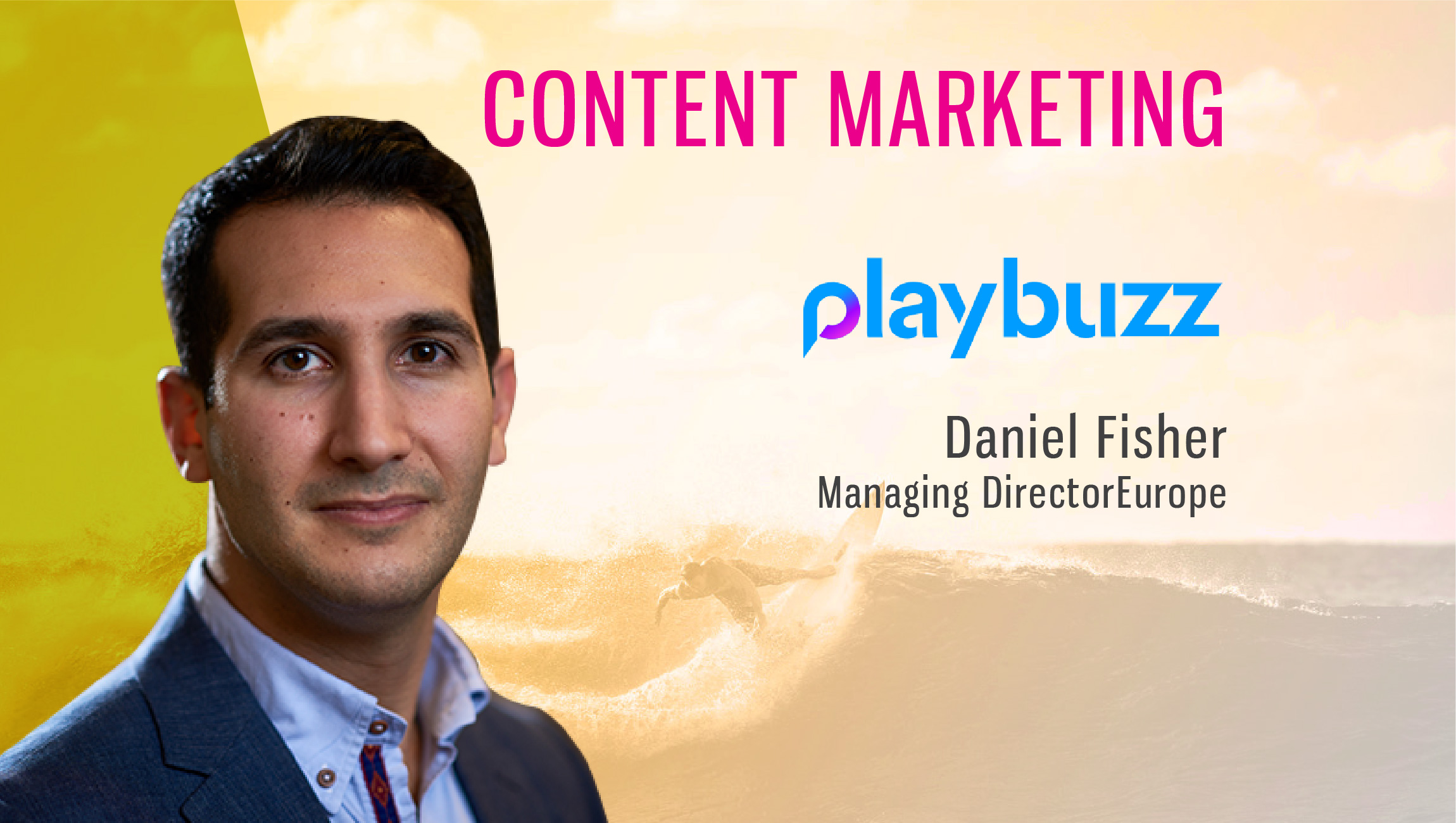Daniel Fisher
Managing Director (Europe) at Playbuzz
Disney-backed storytelling platform, Playbuzz recently published a study showcasing the power of interactive content on branded content campaigns compared to traditional digital content. To better understand the impact of the study and how disruptive forces, including brand safety and fake news, affect branded story-telling, we spoke to Daniel Fisher, Managing Director (Europe) at Playbuzz.
Html code here! Replace this with any non empty text and that's it.
Tell us about your role at Playbuzz and the team/technology you handle.
As Managing Director of Playbuzz Europe, I oversee the growth of the region’s brand, agency and editorial partnerships (existing and new), and lead the company’s strategy and operations in Western Europe. My team has spent most of their careers helping publisher and brand partners drive maximum engagement with readers and consumers.
Our Disney-backed storytelling platform is used both by journalists who rely on our tools to craft and effectively monetize engaging editorial content, as well as advertisers who deploy our advertising products to engage consumers with their brand stories from the top to the bottom of the buying funnel. Partners include Trinity Mirror, Sky, Netflix and government organizations.
What were the main objectives of your recent Nielsen Report?
To understand the true power of engaging content formats (including interactive content), as compared to other forms of traditional digital content, and its impact on consumers and their relationships with brands.
Our proprietary data has shown us that Playbuzz-powered branded content garners an average 85% scroll depth, 4.6% CTR and 2:15 minute dwell time. However, we were intrigued to see whether an independent third-party analysis would reflect the success we were seeing. We also wanted to independently verify how our solutions stack up against the rest of the market in terms of shifting brand metrics.
Based on the results, we’re even more confident that engaging content is a solution to capture the most important – and scarce – a commodity in advertising: the human attention span.
How did you measure Brand Lifts for the respective categories? What analytics did you focus on?
To conduct the study, Nielsen ran a meta analysis using historical brand lift data from 16 Playbuzz-powered UK branded content campaigns across the following categories: Entertainment, Government, Telecommunications, Automotive, Travel, Insurance, Energy & Utilities, Website. Those campaigns were produced for our partners including Sky Q, eBay, The National Counter Terrorism Police, and more.
The results of these studies were then aggregated and benchmarked against global Nielsen Digital Brand Effect (DBE) studies in terms of category and objective norms, for greater sampling and stability versus simply measuring UK studies. The objective norms were: Awareness, Message Association, Intent, Perceptions, Preference.
What is the current state of “Brand Safety” in 2018? How could publishers leverage technology to ensure 100% brand-safety?
The market is much more savvy about brand safety in 2018, with the events of 2017 undoubtedly having made buyers very cautious. And that’s not necessarily a bad thing. It has, however, had an impact on the trust extended to the large platforms.
There are already several technologies out there which seek to address brand safety issues, including Grapeshot, for example. These companies must focus their solutions on both content and context, as that’s what defines the essence of brand safety.
Playbuzz tackles brand safety concerns in a relatively unique way – our platform is used to tell interactive editorial and brand stories in which we can see and understand what those stories are about and also scan them for aspects, including negative keywords. Our technology also knows where all of our content is being served, and offers the ability to optimise campaigns in real-time.
In addition to brand safety, we ensure that we only work with partners who deliver real audiences. Our product only works if a human is engaging with it, as these branded stories are not served in a standard ad format. We’ve had this level of human audience verified by WhiteOps, who confirms that Playbuzz-powered content garners an audience that is 99% human and non-fraudulent, and by MOAT, who reports that our content earns an average 97% viewability rate.
How are you preparing for the post-GDPR era? How would new regulations impact branded content campaigns?
It’s time the industry stops fearing GDPR and starts embracing it. With the regulations demanding that companies revisit and amend their collection and usage practices around personal data, the power is given back to the users and sets a new a standard for security and transparency that the industry is frankly lacking.
Yes – it sounds overwhelming, however, we view this incoming legislation as an opportunity. Although it may limit certain advertising practices, GDPR should genuinely improve online advertising in line with the active trend of cleaning up the internet (see: Google’s coalition for better ads).
GDPR should also signal a shift to a much more personalised and “in control” internet where users get to opt out of the things that they are not interested in — as opposed to having those things determined by past browsing history. The biggest shift will be from personal targeting to behavioural targeting, which falls outside of the legislation provided no personal information is collected.
As a technology company that promotes a positive consumption experience, we will continue to build towards GDPR’s requirements in order to ensure compliance across all of our products by the May 25, 2018 deadline.
What drives brand perceptions for millennial audiences? How do you segment branded content campaigns with relevant personalization?
In advertising terms, millennials are very internet savvy consumers which means that as a group, we see them consuming new ad formats naturally. New is not scary, but instead natural to a generation raised on the internet.
The key when creating campaigns focused on this group is to produce content and ad formats which mirror or compliment the way they consume their media. For example, we ensure that Playbuzz end users do not have to scroll through large bodies of text and that content is visual-first.
A great example that comes to mind of such content is the branded content campaign we created for Netflix. The streaming service’s media agency, Wavemaker, was seeking a new, exciting way to promote Season 5 of “Orange Is The New Black.’’ Following objectives that included creating awareness, social shares, and teasing upcoming storylines, together with the agency, Playbuzz created an immersive, interactive branded story that gave users the opportunity to participate in a scenario-led game, challenging them to break-out of the prison depicted in the show. The story was personalized to the user based on how they interacted with it.
This personalization was a large contributing factor to the 7% share rate that the campaign achieved.
Would you like us to recommend you as a Speaker at relevant technology Events & Conferences?
Yes – I’m always happy to get involved.
Thanks for chatting with us, Daniel.
Stay tuned for more insights on marketing technologies. To participate in our Tech Bytes program, email us at news@martechseries-67ee47.ingress-bonde.easywp.com











